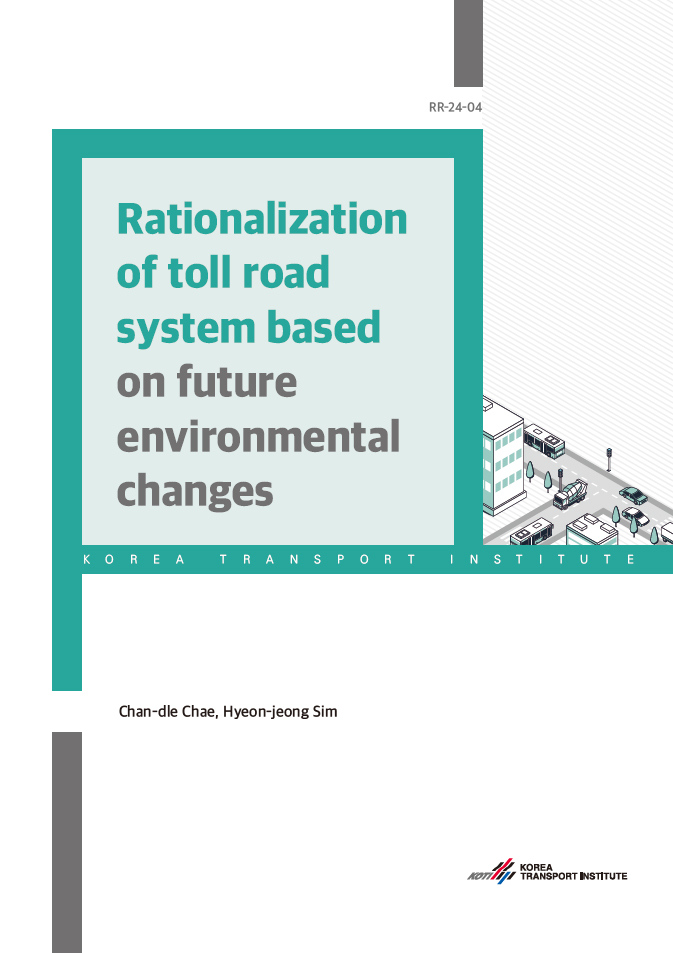Basic Report

RESEARCH
KOTI - Korea Transport institute
(RR-24-04) Rationalization of toll road system based on future environmental changes
- Date
July 01 2025
- Authors
Chan-dle Chae, Hyeon-jeong Sim
- Page(s)
49 page(s)

1. Background and Purpose of the Study
Among the expressways in Korea, those operated by the Korea Expressway Corporation have a two-part toll system consisting of a basic toll and a distance-based toll. A recent review of the Korea Expressway Corporation’s major project expenditures from 2018 to 2023 revealed that, excluding the years 2021 and 2022, expenses for road maintenance and management exceeded road construction costs. Additionally, an analysis of the number of years since the opening of each expressway section showed that 23 out of 97 sections (23.8%) had been in operation for more than 30 years as of January 31, 2024, indicating a significant proportion of aging infrastructure. Notably, sections more than 20 years old accounted for 34%, suggesting that maintenance and management costs will continue to rise due to road aging.
In light of this shift, where road maintenance is becoming more critical than the construction of new routes, it is necessary to reassess whether the two-part toll system introduced in 2004 remains efficient under current and future conditions. Based on toll road depreciation data from the Korea Expressway Corporation covering the period from 2006 to 2020, the average annual depreciation recovery rate was just 0.44%. Assuming no additional construction, it would take 151 years to fully recover the depreciation costs.
Currently, 22 toll reduction and exemption programs are in operation, each introduced with objectives such as promoting welfare or achieving specific policy goals. However, some programs continue to operate despite having already fulfilled their initial objectives, or no longer align with current policy directions due to changes in road conditions or broader policy shifts. Therefore, there is a need to reassess the effectiveness of these programs, estimate their actual impact, and reorganize them accordingly.
This study aims to analyze the limitations of the existing toll system in response to domestic and international changes in the toll road environment, including the emergence of new transportation modes and the shift to mobility services, and to propose improved alternatives and forecast their effects. To this end, the latest condition-related data were collected through literature reviews and other methods; key influencing factors were identified through a Delphi survey of experts; and comparative toll analysis was conducted to derive improvement measures and estimate expected effects.
Among the expressways in Korea, those operated by the Korea Expressway Corporation have a two-part toll system consisting of a basic toll and a distance-based toll. A recent review of the Korea Expressway Corporation’s major project expenditures from 2018 to 2023 revealed that, excluding the years 2021 and 2022, expenses for road maintenance and management exceeded road construction costs. Additionally, an analysis of the number of years since the opening of each expressway section showed that 23 out of 97 sections (23.8%) had been in operation for more than 30 years as of January 31, 2024, indicating a significant proportion of aging infrastructure. Notably, sections more than 20 years old accounted for 34%, suggesting that maintenance and management costs will continue to rise due to road aging.
In light of this shift, where road maintenance is becoming more critical than the construction of new routes, it is necessary to reassess whether the two-part toll system introduced in 2004 remains efficient under current and future conditions. Based on toll road depreciation data from the Korea Expressway Corporation covering the period from 2006 to 2020, the average annual depreciation recovery rate was just 0.44%. Assuming no additional construction, it would take 151 years to fully recover the depreciation costs.
Currently, 22 toll reduction and exemption programs are in operation, each introduced with objectives such as promoting welfare or achieving specific policy goals. However, some programs continue to operate despite having already fulfilled their initial objectives, or no longer align with current policy directions due to changes in road conditions or broader policy shifts. Therefore, there is a need to reassess the effectiveness of these programs, estimate their actual impact, and reorganize them accordingly.
This study aims to analyze the limitations of the existing toll system in response to domestic and international changes in the toll road environment, including the emergence of new transportation modes and the shift to mobility services, and to propose improved alternatives and forecast their effects. To this end, the latest condition-related data were collected through literature reviews and other methods; key influencing factors were identified through a Delphi survey of experts; and comparative toll analysis was conducted to derive improvement measures and estimate expected effects.
[ Contents ]
1. Background and Purpose of the Study
2. Research Methods and Procedures
3. Main Research Contents
3-A. Investigation of Domestic and Foreign Toll Road Toll Systems and Discount and Exemption Systems
3-B. Analysis of Future Environmental Trends Affecting Toll Roads
3-C. Developing a plan to improve the toll road fee system
4. Measures to Improve Laws, Systems, and Utilization
4-A. Measures to Improve Laws and Systems
4-B. Utilization Method
1. Background and Purpose of the Study
2. Research Methods and Procedures
3. Main Research Contents
3-A. Investigation of Domestic and Foreign Toll Road Toll Systems and Discount and Exemption Systems
3-B. Analysis of Future Environmental Trends Affecting Toll Roads
3-C. Developing a plan to improve the toll road fee system
4. Measures to Improve Laws, Systems, and Utilization
4-A. Measures to Improve Laws and Systems
4-B. Utilization Method